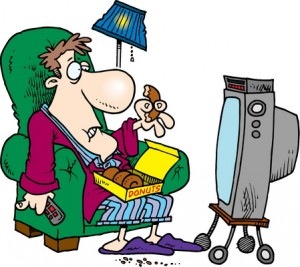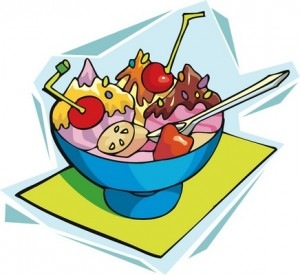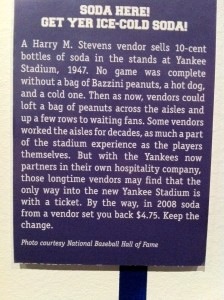
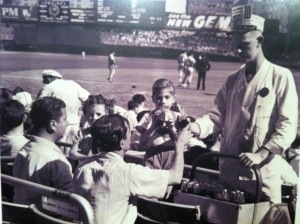 These photos were taken at the Baseball Hall of Fame in Cooperstown, New York which I visited this week. It’s fascinating how food always seems to be incorporated into museums of any kind. As a born and bred New Yorker and a life-long Yankee fan I couldn’t pass up these photos. The same food is still the standard in most ballparks although there are many more choices available, too. It’s nice to know that vendors tossed bags of peanuts then as they still do now. Sort of traditional ballpark behavior, isn’t it?
These photos were taken at the Baseball Hall of Fame in Cooperstown, New York which I visited this week. It’s fascinating how food always seems to be incorporated into museums of any kind. As a born and bred New Yorker and a life-long Yankee fan I couldn’t pass up these photos. The same food is still the standard in most ballparks although there are many more choices available, too. It’s nice to know that vendors tossed bags of peanuts then as they still do now. Sort of traditional ballpark behavior, isn’t it?
Snacking, Noshing, Tasting
Soda Fountains And Egg Creams: Try This At Home
 What’s An Egg Cream?
What’s An Egg Cream?
It isn’t made with eggs or cream. It has a complex taste – sort of like what’s left over in the bottom of your glass after you eat the ice cream out of an ice cream soda. You can’t find bottled egg creams – although companies have tried – because the ingredients separate, the fizz disappears, and the taste just isn’t the same.
A recent article in the New York Times really got me thinking about egg creams. I’ve made hundreds of them. My parents owned an old-fashioned soda fountain in Flushing, Queens (NY) – the kind with a long counter with revolving stools. We sold thousands of egg creams, malteds, cherry cokes (vanilla cokes, too) and for those upset stomachs, old fashioned alka seltzers that you poured from glass to glass to really get a fizz going.
Our soda fountain was half of a large drug store and the pharmacist would sometimes have a small medicine bottle filled up with coke syrup give to someone suffering from some form of GI upset. (Whether or not it actually helped is debatable – psychologically, perhaps it did!).
Historically, fizzy water (essential to an egg cream), was considered medicinal. The first commercial carbonators were found in pharmacies and pharmacists added mineral salts to water to mimic those found in naturally carbonated water. To make the fizzy stuff more tasty and profitable they started flavoring it with sweet syrups (and some not so benign stuff like cocaine and alcohol).
What Happened To Soda Fountain Drinks?
There is some speculation that the bottle cap was the death knell for soda fountain drinks. When fizzy soda in a bottle could be conveniently bought at the gas station, soda mixed at the fountain lost some of its appeal, although, in my experience, people would come for conversation and camaraderie along with the soda.
Lately there’s been a resurgence of soda fountain drinks – many made with home made syrups and organic milk and served by both top notch restaurants and new soda fountains which also aim to be neighborhood gathering spots.
How to Make An Egg Cream
An egg cream is sweet and fizzy and initially were made almost exclusively in New York City. Most people think chocolate — a lot of New Yorkers insist on Fox’s U-Bet Chocolate Syrup — but they can be made with vanilla or strawberry syrup, too.
Most of the “new” makers of egg creams – as well as “old-timers” — agree that cold seltzer made from a carbonator with taps — not the push button soda gun you see behind bars or two-liter bottles of club soda — gives the popping and lively bubbles that make the best drinks. Our fountain had big gas tanks to provide the seltzer water – which inevitably needed changing (by my father) during a very busy lunch hour!
We always used a coke glass and that’s what I remember an egg cream being served in when I ordered it in other places, too. An egg cream needs to be drunk quickly – gulping is okay – because it’ll lose its fizzy head if it sits too long.
Ingredients for a home made egg cream:
- Cold whole milk (low fat or skim won’t foam well)
- Cold seltzer: a soda siphon with a cartridge that carbonates water is great – otherwise, use very cold seltzer
- Chocolate (or vanilla or strawberry) syrup
Preparation:
Some recipes suggest adding the milk first, but this is how we made it (in an 8oz. coke glass):
- Put about an inch of syrup into a soda glass (you can adjust for sweetness with more or less syrup)
- Layer on about an inch of cold milk
- Fill to the top with cold seltzer
- Stir with a long spoon until it gets a fizzy head
Drink up!
A Dozen Reasons We Eat When We’re Not Hungry
Eating when you’re not hungry, or when you’re bored, angry, tired, procrastinating, or celebrating can push your calorie intake way up. The biggest problem is that we often don’t realize that we’re shoving food into our mouths – either because we’re distracted, we don’t want to know, or we just plain old don’t care.
Here are a dozen reasons and triggers for “mindless” eating:
- “Cheap” calories – the kind you find at all you can eat restaurants, those freebie tastes in markets, “value meals,” and three courses for the price of two.
- Bread and extras like butter, olive oil, and olives on the table or peanuts or pretzels at a bar. Way too tempting to pass up – especially if you’re hungry or you’ve walked in with the attitude that you “deserve” it because you’ve had a rotten day.
- Opening your cabinet or refrigerator door and having your favorite snacks staring you in the face.
- Procrastinating or avoiding doing what you have to do by having a snack.
- Family gatherings that serve traditional and/or highly caloric foods that you wouldn’t normally eat – and a whole bunch of angst that causes you to eat.
- Watching TV with a bag of chips or a bowl of candy on your lap.
- Parties and events — especially when you drink — causing you to lose count and control of what you’re grabbing to eat.
- Sitting near a vending machine or the snack room at work – and the candy bowls on a lot of desks.
- Buffets – anywhere and everywhere . Oh, the heaps and piles of good looking food. Enough said.
- Feeling tired, bored, angry, or “out-of-sorts” and looking for food as a “pick-me-up.”
- Having a stressful – or boring –meeting especially when there’s a table full of food nearby.
- Getting home, having no plan for dinner, and just picking and nibbling a ton of calories all evening.
What are your reasons?
Buy Me Some Peanuts And Cracker Jacks
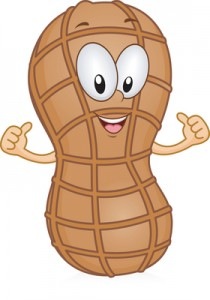 Happy Summer! Baseball season is in full swing and so are visits to amusement parks. What do you usually do at these places – other than watch the game, ride the roller coaster? EAT, of course!
Happy Summer! Baseball season is in full swing and so are visits to amusement parks. What do you usually do at these places – other than watch the game, ride the roller coaster? EAT, of course!
Oh, the food! Oh the calories! Hang on – this post is not about ignoring the good time food. Of course, there are always healthy food options: you can bring your own or be scrupulous in making healthy choices. But honestly, do you think that most people really want to eat low calorie foods when they’re at a ballgame or amusement park? No way.
So what do you do when you’re at these places with food vendors about every 20 feet hawking dogs, ice cream, and beer?
There Are Ways And Then There Are Ways
If you’ve got a will of iron, I guess you could ignore the food and drinks. But if you’re like most people and you’re tempted at every turn, you can try to minimize the damage without taking out the fun. If you know you’re going to be having a stadium or food court meal, do some thinking, planning, and learning. The best choices are not always the obvious ones.
Do you need both peanuts and popcorn? Can you make do with a regular hot dog instead of a foot-long? Can you keep it to one or two beers instead of three? Can you choose the small popcorn instead of the jumbo tub?
Make Your Best Choice
Here’s some info to help you make your best choice. Just a heads up – we’re not talking about the most nutritious choice because given these foods, quality nutrition is not front and center. You can, however, enjoy your day and make the best caloric choice (with a nod to fat and sugar content) and still eat traditional ballpark and amusement park food.
- Cotton Candy: Nothing but heated and colored sugar that’s spun into threads with added air. Cotton candy on a stick or wrapped around a paper cone (about an ounce) has around 105 calories; a 2oz. bag (common size) has 210. A lot of sugar, but not a lot of calories – albeit empty ones.
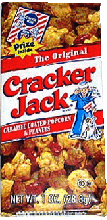 Cracker Jack (officially cracker jack, not jacks): candy-coated popcorn with some peanuts. A 3.5oz stadium size box has 420 calories but does have 7g protein and 3.5g fiber.
Cracker Jack (officially cracker jack, not jacks): candy-coated popcorn with some peanuts. A 3.5oz stadium size box has 420 calories but does have 7g protein and 3.5g fiber.
- Hamburger: 6oz. of beef with a bun has about 490 calories — without cheese or other toppings — which up the ante.
- Grilled Chicken Sandwich, 6oz.: 280 calories – not a bad choice. 6oz. of chicken tenders clock in at 446 calories. Barbecue dipping sauce adds 30 calories a tablespoon.
- Hot Dog: Most sold out stadiums can sell 16,000 hot dogs a day. A regular hot dog with mustard has about 290 calories: 180 for the 2oz. dog, 110 for the bun, zilch for regular yellow mustard. Two tbs. sauerkraut adds another 5-10 calories, 2 tbs. ketchup adds 30, and 2 tbs. relish another 40. A Nathan’s hot dog racks up 320 calories; a foot-long Hebrew National 510 calories. Hot dogs are usually loaded with sodium.
- Pizza: Stadium pizza is larger than a usual slice, about 1/6 of a 16-inch pie (instead of 1/8) making it about 435 calories a slice.
- Super Nachos with Cheese: A 12oz. serving (40 chips, 4oz. cheese) has about 1,500 calories!!! Plain French fries look like a caloric bargain by comparison.
- French Fries: A large serving has about 500 calories. A serving of Hardee’s chili cheese fries has 700 calories and 350 of them come from fat.
- Potato Chips: One single serving bag has 153 calories (94 of them from fat).
- Peanuts in the Shell: What would a baseball game be without a bag of peanuts? Stadiums can sell as many as 6,000 bags on game days. An 8oz. bag has 840 calories; a 12oz. bag has 1,260. Yes, they have some protein and fiber. But wow on the calories.
- Soft Pretzel: One large soft pretzel has 483 calories – giant soft pretzels (7-8oz.) have about 700 calories.
- Draft Beer: A stadium draft beer, 20oz. cup, the usual size, has about 240 calories. A light draft saves you 60 calories.
- Coca Cola: A 12oz can: 140 calories –- and close to 10 tsp. of sugar.
- Helmet Ice Cream: Your team’s mini-helmet filled with swirly Carvel, 550-590 calories.
- Souvenir Popcorn: At Yankee Stadium a jumbo size has 1,484 calories and a souvenir bucket has 2,473 calories.
Sources:
http://www.fatsecret.com/calories-nutrition
http://www.active.com/nutrition/
http://www.drweigh.com/blog/
Calories Don’t Count When . . .
- You snag 3 tootsie rolls from the receptionist’s desk
- You grab a couple of samples of cheesecake at Costco
- You finish your child’s grilled cheese sandwich
- You taste the cookie batter and lick the bowl and beaters
- You finish the leftovers because there’s too small an amount to save
How many more can you add?
Calories Do Count
Obviously, the calories do count, it’s just that all too frequently we neglect to add them – remember them – or acknowledge them (that would mean having to admit that you ate that candy bar).
That’s why a food journal can help with weight management. By writing down everything that you eat – not at the end of the day but when you eat it – you’re forced to acknowledge all of the random food that you either mindfully or mindlessly pop into your mouth.
The Center for Science in the Public Interest uses frozen yogurt to illustrate how mindlessly adding toppings adds a whopping amount of calories to what might be thought of as a healthy food.
“Let’s say you start with just 200 to 300 calories’ worth of frozen yogurt. (That’s a medium or regular at places like Red Mango, Pinkberry, or TCBY.)
But then the toppings call out. Forget the chocolate chips (80 calories per scoop), the gummy bears (80), and the Oreo pieces (60). Even the ‘healthy’ toppings like granola (60 calories), nuts (100), and ‘yogurt’ chips (100) pile on the calories.”
Think about it: when don’t your calories count?
